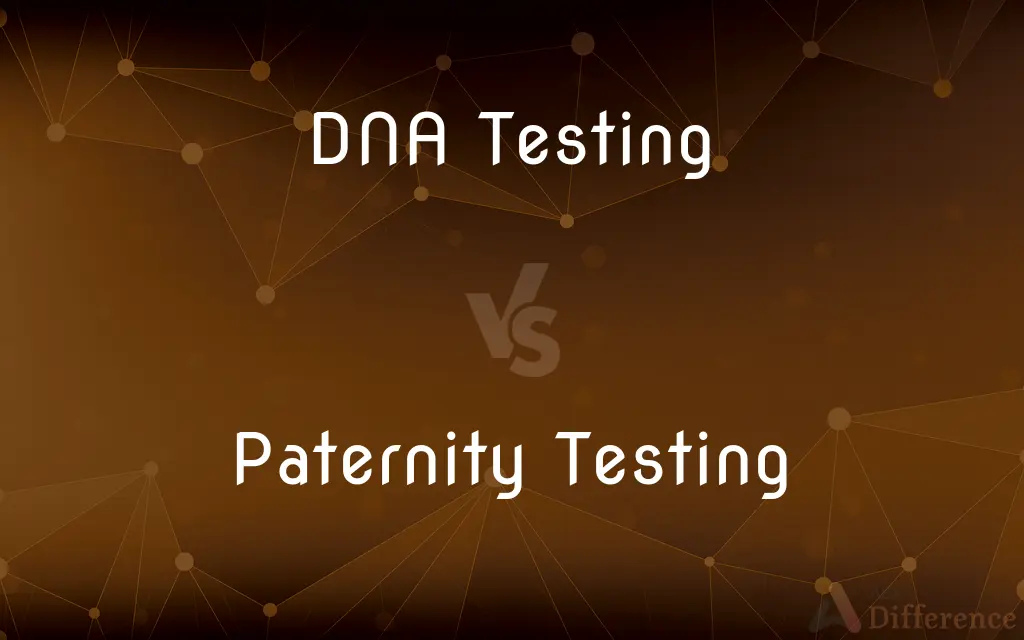DNA Testing vs. Paternity Testing — What's the Difference?
Edited by Tayyaba Rehman — By Maham Liaqat — Published on February 21, 2024
DNA testing is a broad term for analyzing genetic material to identify genetic links, health conditions, or ancestry, while paternity testing is a specific type of DNA testing to determine if a man is the biological father of a child.

Difference Between DNA Testing and Paternity Testing
Table of Contents
ADVERTISEMENT
Key Differences
DNA testing encompasses a wide range of applications, from forensic analysis and genetic disorder screening to determining biological relationships and ancestry. It involves examining an individual's genetic code, present in their DNA, to gather information about their genetics. This can include identifying genetic markers for diseases, understanding genetic predisposition to certain health conditions, tracing family lineage, or solving crimes through genetic evidence.
Paternity testing, on the other hand, is a focused application of DNA testing aimed at establishing fatherhood. By comparing the DNA of a child with that of the presumed father, paternity tests can confirm or exclude biological paternity with high accuracy. This process typically looks at specific regions in the DNA where genetic variations are known to occur and assesses whether the child has inherited these from the alleged father.
All paternity tests are DNA tests, not all DNA tests are for determining paternity. The choice between DNA testing and paternity testing depends on the information sought. For questions about fatherhood, paternity testing is the go-to option. However, for broader genetic inquiries, such as health predispositions or ancestry, broader DNA testing is more appropriate.
Comparison Chart
Purpose
Broad range of applications including health, ancestry, and relationships
Specifically determines biological fatherhood
Genetic Analysis
Can analyze entire genome or specific markers depending on the test
Focuses on markers that can confirm or exclude a paternal link
ADVERTISEMENT
Applications
Medical diagnostics, forensic analysis, ancestry, kinship
Legal and personal confirmation of a father-child relationship
Results
Varied, can provide information on health risks, ancestral background, or biological relationships
Provides a probability of paternity, usually above 99% for confirmation
Sample Collection
Blood, saliva, or cheek swab, depending on the test
Typically a cheek swab from the child and alleged father
Compare with Definitions
DNA Testing
Used for kinship testing beyond paternity, like sibling or maternity tests.
DNA testing confirmed their biological relationship as siblings.
Paternity Testing
Can be conducted before or after a child's birth.
Prenatal paternity testing was conducted through a non-invasive blood test.
DNA Testing
Can trace genetic heritage and ancestral origins.
Ancestry DNA tests showed a mixture of European and Asian heritage.
Paternity Testing
Provides peace of mind or legal evidence of biological relationship.
The paternity test provided the evidence needed for the child's inheritance rights.
DNA Testing
Used in forensic science to identify individuals.
DNA testing helped solve a decades-old crime case.
Paternity Testing
Determines if a man is the biological father of a child.
A paternity test confirmed his fatherhood with 99.9% certainty.
DNA Testing
Analyzes genetic material to provide information on health, ancestry, or relationships.
DNA testing can reveal if you're predisposed to certain genetic conditions.
Paternity Testing
Often used in legal contexts for child support or custody cases.
The court ordered a paternity test to settle the custody dispute.
DNA Testing
Helps in identifying genetic disorders.
Genetic testing confirmed a diagnosis of cystic fibrosis.
Paternity Testing
Typically requires samples from the child and alleged father.
Cheek swabs from both were sent for paternity testing.
Common Curiosities
Do you need the mother's DNA for a paternity test?
While not necessary, including the mother's DNA can improve the accuracy and efficiency of the paternity test by eliminating the maternal side of the child's DNA from consideration.
Is paternity testing accurate?
Paternity testing is highly accurate, often providing a probability of paternity that is 99% or higher when the alleged father is indeed the biological father.
What is DNA testing used for?
DNA testing is used for a variety of purposes, including medical diagnosis, ancestry research, forensic investigation, and establishing biological relationships.
Can DNA testing determine other family relationships besides paternity?
Yes, DNA testing can also determine other family relationships, such as maternity, siblings, or grandparents, by analyzing shared genetic markers.
How does paternity testing work?
Paternity testing compares specific regions of DNA between the child and the alleged father to see if there is a match that indicates biological paternity.
Are the results of DNA and paternity testing confidential?
Yes, the results are typically kept confidential and are released only to the individuals who have the legal right to access them.
How long does it take to get results from a paternity test?
Results from a paternity test can typically be expected within a few days to a couple of weeks, depending on the lab and the type of test.
Can DNA testing reveal health information?
Yes, certain DNA tests are designed to identify genetic predispositions to various health conditions and diseases.
Can paternity testing be done before a baby is born?
Yes, prenatal paternity testing can be conducted using non-invasive methods that analyze fetal DNA present in the mother's blood.
What's the difference between at-home and legal paternity tests?
At-home paternity tests are for personal knowledge and may not be admissible in court, while legal paternity tests follow a chain of custody and can be used for legal purposes.
Share Your Discovery

Previous Comparison
Mack Trucks vs. Peterbilt Trucks
Next Comparison
Platinum vs. DiamondAuthor Spotlight
Written by
Maham LiaqatEdited by
Tayyaba RehmanTayyaba Rehman is a distinguished writer, currently serving as a primary contributor to askdifference.com. As a researcher in semantics and etymology, Tayyaba's passion for the complexity of languages and their distinctions has found a perfect home on the platform. Tayyaba delves into the intricacies of language, distinguishing between commonly confused words and phrases, thereby providing clarity for readers worldwide.














































